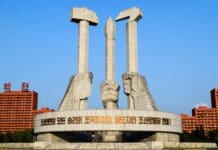This post is also available in:
 עברית (Hebrew)
עברית (Hebrew)

Aleppo province
In the area of Aleppo, battles took place between ISIS operatives and Shiite militias. According to Orient News TV, about 200 Shiite militia operatives, who came to Syria from Iraq, Iran and Afghanistan, have been killed fighting against ISIS in the northern part of the Aleppo province (Orient News, February 18, 2015).
On February 19, 2015, the owner of an ISIS-affiliated Twitter account posted a photo showing around 35 people who were captured by ISIS. He noted that the prisoners belong to Hezbollah or to Shiite militias supported by it. The photo also shows three bodies in uniform (ISIS-affiliated Twitter account, January 19, 2015). At this stage, it is unclear whether the prisoners in question are Hezbollah operatives or operatives from the Shiite militias supported by Iran and Hezbollah.
Damascus province
Near the town of Al-Set Zaynab, a car bomb attack was carried out at a checkpoint manned by the Troops for the Defense of the Homeland (a semi-military force of the Syrian regime) and Hezbollah operatives. The explosion killed six people and wounded more than 10. The town of Al-Set Zaynab is a center for Hezbollah operatives and Shiite militias who come from Iran, Iraq and Lebanon to fight in Syria. On several occasions in the past, jihadi organizations tried to attack the Al-Set Zaynab compound and the forces that protect it, including through the use of suicide bombers and car bombs.
There are dozens of sites in Syria that are sacred to the Shiites, the most prominent of which is the tomb of Al-Set Zaynab (or Al-Sayyida Zaynab), the daughter of Imam Ali bin Abi Talib, the founder of Shiite Islam, and the granddaughter of the Prophet Muhammad. The tomb is a pilgrimage site for Shiites from around the world, particularly from Iran, Iraq, Lebanon, the Gulf States, India, Pakistan and Afghanistan. In late 2012 – early 2013, a Shiite militia was established to defend the tomb of Al-Set Zaynab from attacks by elements affiliated with the global jihad. This militia includes Shiite fighters from Iraq, Syria, Lebanon, Iran, Pakistan and Afghanistan (Al-Arabiya TV, April 5, 2013).
The area of Kobani (Ayn al-Arab)
It was recently reported that Kurdish units (YPG), aided by Peshmerga forces (who reached Syria) and the Free Syrian Army, in coordination with the international coalition forces, have managed to get close to the city of Tal Abyad, which is controlled by ISIS. They also took over areas between Kobani and Tal Abyad, in order to open the roads between the two cities (Al-Safir, February 21, 2015). ISIS, which is now concentrating its troops on this front, has begun to move operatives from the provinces of Deir al-Zor and Al-Raqqah to Tal Abyad (Al-Manar TV, February 23, 2015).
Register to iHLS Israel Homeland Security
The Kurdish forces (YPG) therefore continue to take advantage of their successful takeover of the city of Kobani, repelling ISIS from the surrounding countryside and expanding their control along the border with Turkey. The ISIS-controlled city of Tal Abyad is located to the west of Kobani and near one of the border crossings leading from Syria to Turkey. If the Kurdish forces manage to take over Tal Abyad, they will establish a territorial control zone for themselves along the Turkish border, presenting a challenge to ISIS.
Evacuation of the tomb of Suleyman Shah Enclave in Syria
On the night of February 21-22, 2015, following an advance by ISIS operatives, Turkey evacuated the tomb of Suleyman Shah, Turkish enclave of historic importance in Syria, located south of Kobani (around 35 km south of the border). The evacuation was carried out jointly by the Turkish Army and the Turkish intelligence services, without a confrontation with ISIS operatives. At the end of the operation, which involved UAVs, helicopters, armored vehicles and Special Forces, the forces blew up the compound. During the evacuation, a Turkish soldier was killed. According to the Turkish Prime Minister, the remains of the tomb are being held temporarily in Turkey and will be moved to another area controlled by the Turkish Army in northern Syria (Hürriyet, February 22, 2015). The area of the tomb of Suleyman Shah, who was the grandfather of the founder of the Ottoman Empire, was recognized in 1921 as Turkish territory in an agreement signed with France, and it is of historical and symbolic significance for Turkey. Until recently, the compound was manned by around 40 Turkish soldiers. When ISIS reached the area, the Turks found it difficult to transfer supplies to their soldiers and send in replacements. In March 2014, ISIS issued an ultimatum to Turkey, ordering it to evacuate the compound, otherwise they would take it over. Until recently, Turkey did not assent to this demand. Turkey’s response to the demand to evacuate the compound, albeit after such a long time, represents an achievement for ISIS. However, evacuating the enclave may release Turkey from potential pressure from ISIS.
The area of Al-Qalamoun (the Syrian-Lebanese border)
It was reported that Abu Aisha al-Baniasi, the “Emir” of ISIS in the Al-Qalamoun area, was liquidated following internal disagreements at the top of the organization (Al-Mayadeen, February 23, 2015). His liquidation is liable to weaken ISIS’s position in the area of the Syrian-Lebanese border, which serves as a starting point for operations in Lebanon.
Al-Hasakah province
After clashes with ISIS, it was reported that Kurdish forces took over twenty villages in the Al-Hasakah province (Akhbar Al-Aan, February 23, 2015). On the other hand, it was reported that ISIS operatives took over a number of Assyrian villages in the province and that they are holding hostages (Al-Arabiya al-Hadath, February 23, 2015).
Written by: The Meir Amit Intelligence and Terrorism Information Center (ITIC)

























